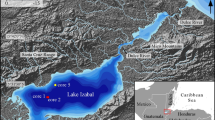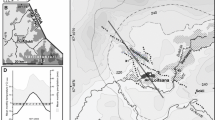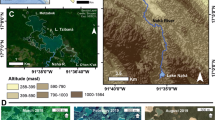Abstract
A continuous high-resolution (monthly) record of stable isotopes (δ13C and δ18O) in a well-laminated freshwater travertine deposited at Baishuitai, SW China from May 1998 to November 2001 was presented. The travertine exhibits clear annual bands with coupled brown/white color laminations. Throughout field investigation, it was found that the thin (1.5–2.2 mm), brown porous lamina was formed in the monsoonal rainy season from April to September, whereas the thick (5–8 mm), dense white lamina was formed in the dry season from October to March. The comparisons of lamina thickness and stable isotope signals in the travertine with the meteorological records allow us to constrain the relevant geochemical processes in the travertine formation under different climate conditions and to relate climate variables to their physicochemical proxies in the travertine record. Sympathetic variations in lamina thickness, δ13C and δ18O along the sampled profile reflect changes in hydrogeochemistry, showing that thin lamina and low δ13C and δ18O values occur in warm and rainy seasons. The decreased amount of calcite precipitation and low δ13C values during the warm and rainy seasons is caused by dilution of overland flow after rainfall. The low δ18O values are believed to be related to the rainfall amount effect in subtropical monsoonal regions. This process is thought to be markedly subdued whenever the amount of rainfall is lower than a given threshold. Accordingly, distinct minima in lamina thickness, δ13C and δ18O are interpreted to reflect events with above-average rainfall, possibly heavy floods, and vice versa. This study demonstrates the potential of freshwater travertine to provide valuable information on seasonal or even monthly rainfall variations.








Similar content being viewed by others
References
Andrews JE, Brasier AT (2005) Seasonal records of climatic change in annually laminated tufas: short review and future prospects. J Quaternary Sci 20:411–421
Andrews JE, Riding R, Denn PF (1997) The stable isotope record of environmental and climatic signals in modern terrestrial microbial carbonates from Europe. Palaeogeogr Palaeoclimatol Palaeoecol 129:171–189
Baker A, Smart PL, Edwards RL, Richards A (1993) Annual growth bandings in a cave stalagmite. Nature 364:518–520
Baldini JUL, McDermott F, Fairchild IJ (2002) Structure of the 8200-year cold event revealed by a speleothem trace element record. Science 296:2203–2206
Bar-Matthews M, Ayalon A, Matthews A, Sass E, Halicz L (1996) Carbon and oxygenisotope study of the active water-carbonate system in a karstic Mediterranean cave: implications for paleoclimate research in semiarid regions. Geochim Cosmochim Acta 60:337–347
Buhmann D, Dreybrodt W (1985) The kinetics of calcite dissolution and precipitation in geologically relevant situations of karst areas. 1 Open Syst Chem Geol 48:189–211
Charles CD, Hunter DE, Fairbanks RG (1997) Interaction between the ENSO and the Asian monsoon in a coral record of tropical climate. Science 277:925–928
Dansgaard W (1964) Stable isotopes in precipitation. Tellus 16:436–468
Dorale JA, Edwards RL, Ito E, González LA (1998) Climate and vegetation history of the Midcontinent from 75 to 25 ka: a speleothem record from Crevice Cave, Missouri, USA. Science 282:1871–1874
Drake JJ, Wigley TML (1975) The effect of climate on the chemistry of carbonate groundwaters. Water Resour Res 11:958–962
Fleitmann D, Burns SJ, Mudelsee M, Neff U, Kramers J, Mangini A, Matter A (2003) Holocene forcing of the Indian monsoon recorded in a stalagmite from Southern Oman. Science 300:1737–1739
Ford TD, Pedley HM (1996) A review of tufa and travertine deposits of the world. Earth Sci Rev 41:117–175
Ford TD, Williams PW (1988) Karst geomorphology and hydrology. Unwin Hyman Academic, London
Frappier A, Sahagian D, González LA, Carpenter SJ (2002) El Niño events recorded by stalagmite carbon isotopes. Science 298:565
Ihlenfeld C, Norman MD, Gagan MK, Drysdale RN, Maas R, Webb J (2003) Climatic significance of seasonal trace element and stable isotope variations in a modern freshwater tufa. Geochim Cosmochim Acta 67:2341–2357
Kano A, Matsuoka J, Kojo T, Fujii H (2003) Origin of annual laminations in tufa deposits, southwest Japan. Palaeogeogr Palaeoclimatol Palaeoecol 191:243–262
Liu Z, Yuan D, He S, Zhang M, Zhang J (2000) Geochemical features of the geothermal CO2-water-carbonate rock system and analysis on its CO2 sources. Sci China (D) 43:569–576
Liu Z, Zhang M, Li Q, You S (2003) Hydrochemical and isotope characteristics of spring water and travertine in the Baishuitai area (SW China) and their meaning for paleoenvironmental reconstruction. Environ Geol 44:698–704
Liu Z, Li Q, Sun H, Wang J, Wu K (2006) Diurnal variations of hydrochemistry in a travertine-depositing stream at Baishuitai, Yunnan, SW China. Aquat Geochem 12:103–121
Matsuoka J, Kano A, Oba T, Watanabe T, Sakai S, Seto K (2001) Seasonal variation of stable isotopic compositions recorded in a laminated tufa, SW Japan. Earth Planet Sci Lett 192:31–44
McDermott F, Mattey DP, Hawkesworth C (2001) Centennial-scale Holocene climate variability revealed by a high-resolution speleothem δ18O record from SW Ireland. Science 294:1328–1331
Montoya M, Crowley TJ, Storch H (1998) Temperatures at the last interglacial simulated by a coupled ocean-atmosphere climate model. Paleoceanography 13:170–177
Rozanski K, Araguas-Araguas L, Gonfiantini R (1992) Relation between longterm trends of oxygen-18 isotope composition of precipitation and climate. Science 258:981–985
Smith JR, Giegengack R, Schwarcz HP (2004) Constraints on Pleistocene pluvial climates through stable-isotope analysis of fossil-spring tufas and associated gastropods, Kharga Oasis, Egypt. Palaeogeogr Palaeoclimatol Palaeoecol 206:157–175
Tudhope AW, Chilcott CP, McCulloch MT, Cook ER, Chappell J, Ellam RM, Lea DW, Lough JM, Shimmield GB (2001) Variability in the El Niño-Southern Oscillation through a glacial–interglacial cycle. Science 291:1511–1517
Wang YJ, Cheng H, Edwards RL, An ZS, Wu JY, Shen C, Dorale JA (2001) A high-resolution absolute-dated Late Pleistocene monsoon record from Hulu Cave, China. Science 294:2345–2348
Wigley TML (1977) WATSPEC. A computer program for determining the equilibrium of aqueous solutions. Br Geomorphol Res Group Tech Bull 20:1–46
You S (2003) The evolution of hydrochemistry and carbon and oxygen isotopes in Baishuitai Travertine scenic area and its environmental significance. Master degree thesis, Guangxi Normal University
Yuan D, Cheng H, Edwards RL, Dykoski CA, Kelly MJ, Zhang M, Qing J, Lin Y, Wang Y, Wu J, Dorale JA, An Z, Cai Y (2004) Timing, duration, and transitions of the last interglacial Asian monsoon. Science 304:575–578
Zhang X, Nakawo M, Yao T, Han J, Xie Z (2002) Variations of stable isotopic compositions in precipitation on the Tibetan Plateau and its adjacent regions. Sci China 45:481–493
Acknowledgments
This work was supported by the National Natural Science Foundation of China (Grant Nos. 40372117 and 40572017), Ministry of Science and Technology of China (Grant No. 2005DIB3J067), Ministry of Land and Resources of China (Grant No. 9806).
Author information
Authors and Affiliations
Corresponding author
Rights and permissions
About this article
Cite this article
Liu, Z., Li, H., You, C. et al. Thickness and stable isotopic characteristics of modern seasonal climate-controlled sub-annual travertine laminas in a travertine-depositing stream at Baishuitai, SW China: implications for paleoclimate reconstruction. Environ Geol 51, 257–265 (2006). https://doi.org/10.1007/s00254-006-0323-0
Received:
Accepted:
Published:
Issue Date:
DOI: https://doi.org/10.1007/s00254-006-0323-0




